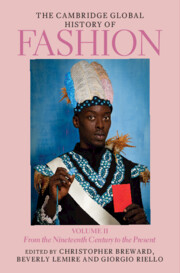Book contents
- The Cambridge Global History of Fashion
- The Cambridge Global History of Fashion
- The Cambridge Global History of Fashion
- Copyright page
- Contents for Volume II
- Figures for Volume II
- Maps for Volume II
- Table for Volume II
- Contributors for Volume II
- Preface
- Part IV Fashion, Modernism, and Modernity
- Part V Fashion, Colonialism, and Post-Colonialism
- 29 Chinese Coolie Hats
- 30 Crumbling Empires and Emerging Nations
- 31 Gender, Nation, Fashion, and Modernities in the Asia-Pacific, 1900 to the Present
- 32 The Global Politics of Wearing, Buying, and Selling European-Style Dress, c. 1900–1930
- 33 Fashioning Diasporas
- 34 Colonial Fashion Histories
- Part VI Fashion Systems and Globalization
- Index
- References
31 - Gender, Nation, Fashion, and Modernities in the Asia-Pacific, 1900 to the Present
from Part V - Fashion, Colonialism, and Post-Colonialism
Published online by Cambridge University Press: 04 August 2023
- The Cambridge Global History of Fashion
- The Cambridge Global History of Fashion
- The Cambridge Global History of Fashion
- Copyright page
- Contents for Volume II
- Figures for Volume II
- Maps for Volume II
- Table for Volume II
- Contributors for Volume II
- Preface
- Part IV Fashion, Modernism, and Modernity
- Part V Fashion, Colonialism, and Post-Colonialism
- 29 Chinese Coolie Hats
- 30 Crumbling Empires and Emerging Nations
- 31 Gender, Nation, Fashion, and Modernities in the Asia-Pacific, 1900 to the Present
- 32 The Global Politics of Wearing, Buying, and Selling European-Style Dress, c. 1900–1930
- 33 Fashioning Diasporas
- 34 Colonial Fashion Histories
- Part VI Fashion Systems and Globalization
- Index
- References
Summary
Filipino politicians are expected to participate in a fashion parade each year. Since about the end of the 1990s the annual President’s State of the Nation Address (SONA) in the Philippines has been preceded by an event in which the parliamentarians of both houses of the senate and congress and their partners or spouses are expected to walk down a red carpet attired in couture versions of the national dress especially tailor-made for this occasion. In 2014 the television channel ABS-CBNnews.com ran a People’s Fashion Choice contest on Facebook for the best-dressed attendee. The shortlist of ten contestants were all women composed of both politicians and those linked to male politicians as spouses, mothers, or sisters and therefore very influential, as in the Philippines power is held by kinship alliance groups.
- Type
- Chapter
- Information
- The Cambridge Global History of FashionFrom the Nineteenth Century to the Present, pp. 1091 - 1122Publisher: Cambridge University PressPrint publication year: 2023



